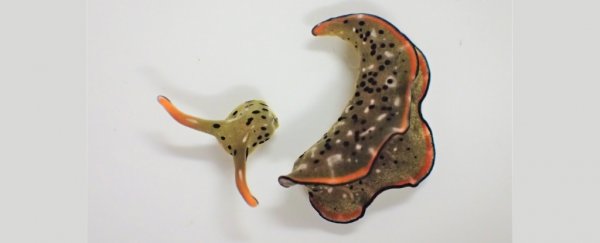Regeneration is a fairly widespread ability in the animal kingdom - for increasing long-term survival chances, you simply can't beat the option to regrow entire limbs or organs. But these two species of sacoglossan sea slug take it to the extreme.
They can decapitate themselves, and then regrow an entire new body from the neck down, functional organs and all. It's not even a reproductive tactic - the discarded body eventually dies, while the slug lives on with its new one.
It's not quite clear why the two animals - Elysia cf. marginata and E. atroviridis - developed this superpower, but biologists Sayaka Mitoh and Yoichi Yusa of Nara Women's University in Japan believe it may help rid the slugs of pesky parasites that hinder their reproduction.
If that's the case, it would officially be the most dramatic and metal parasite control technique we've ever heard of.
The discovery, the researchers report, was an accidental one. In his lab, Yusa and his students study sea slugs for their entire life cycle. Mitoh was working with the animals one day when she saw one that had autotomised; that is, dropped part of its body, like a lizard dropping its tail.
Except, it wasn't just a tail. The entire body had been dropped - and the head was moving around on its own.
"We were surprised to see the head moving just after autotomy," she said. "We thought that it would die soon without a heart and other important organs, but we were surprised again to find that it regenerated the whole body."
The researchers set out to study what was going on, and found an astonishing process.
Within a few hours of autotomy, the heads of young slugs started feeding. The wound at the neck healed within a few days. The heart started regenerating within a week - and within just three weeks, the sea slug had a whole new body, good as new. One individual even did it twice.
 From left to right: Day 0, day 7, day 14 and day 22. (Mitoh & Yusa, Curr. Biol., 2021)
From left to right: Day 0, day 7, day 14 and day 22. (Mitoh & Yusa, Curr. Biol., 2021)
Older slugs didn't seem to have the same resilience. Once their bodies fell off, they continued to move around, but didn't feed, dying after about 10 days. All the bodies, meanwhile, continued to move around without regenerating a new head, for a period of up to a few months, their hearts continuing to beat right up until they started to decompose.
Although the trigger for the sea slugs' autotomy is unknown, there are a few clues that suggest why they might want to regrow their entire body.
Firstly, all the sea slugs that decapitated themselves were infested with parasites. When they regrew their bodies, the slugs were parasite-free. In addition, no sea slugs autotomised that were free of parasites to start with.
Some wild-caught individuals of E. atroviridis had parasites only on parts of their bodies; in those cases, the sea slugs seem to have self-digested and regrown only those parts of their bodies, thus discharging the parasites. (You read that right.)
Finally, the team imitated predator attacks to find out if - like lizards, for example - the sea slugs can drop a part of their body as a means of escape. It didn't work, and the sea slugs remained intact.
Since other species can autotomise parts of their body as a means of parasite removal, at this stage the researchers' interpretation seems the most likely.
Meanwhile, the team is still a little confused as to how the sea slug heads can remain alive detached from the bodies that contain hearts and other important organs. They think it might have something to do with how these slugs produce energy.
Sacoglossan sea slugs eat algae, but they don't just digest it, boom, done. Their bodies incorporate the algae's chloroplasts, allowing the creatures to photosynthesise - a fascinating phenomenon known as kleptoplasty.
This theft is only temporary - the sea slugs have to replenish the chloroplasts by eating more algae - but the researchers think that being able to photosynthesise for a short time may keep the heads alive long enough to regenerate a body. This would also explain how the bodies are able to keep moving around for so long without heads to feed them.
The strange, whole-body autotomy of E. cf marginata and E. atroviridis therefore represents an excellent research opportunity, the researchers said.
"As the shed body is often active for months, we may be able to study the mechanism and functions of kleptoplasty using living organs, tissues, or even cells," Mitoh said.
"Such studies are almost completely lacking, as most studies on kleptoplasty in sacoglossans are done either at the genetic or individual levels."
Arm-Fall-Off-Boy, eat your heart out.
The research has been published in Current Biology.
